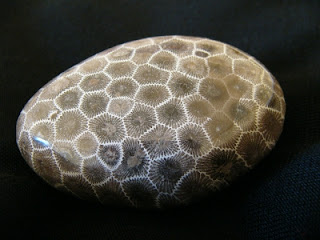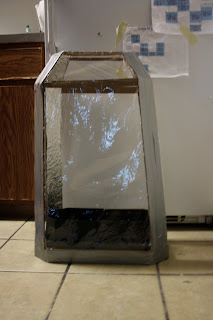Anica Presley
CFC III: Nature
Jessica Frelinghuysen
31 January 2013
Natural
Patterns: Symmetry
Symmetry in the general sense refers to
proportion and repetition. The term is used by many different professions and
areas of study, each with their own specific understanding of its meaning.
Biological symmetry refers to the various naturally occurring patterns found in
everything from molecules, plants and animals, to the universe as a whole.
Humans were fascinated by symmetry long before some of these discoveries were
made. Artists, architects, and designers study and manipulate symmetry’s visual
implications. However, all human fascination with the subject comes from what
can be observed around us. Thus, leading to do in a study of symmetry is to go
back to the source, nature. Classification of symmetries varies across the
board. However, they can be classified into two groups: point and space. Point
groups have one unique point that differs from all others and remains
unchanged. Symmetries in the point group include radial and mirror or
bi-lateral. Space groups tend to have a repeating shape or pattern within a
designated space. This includes wallpaper and stripe pattern symmetries. The
most commonly discussed are point groups. Thus, I will begin by explaining the
two aforementioned space groups and follow up with point groups.

Wallpaper
symmetry appears more in math than it does in nature. However, a naturally
occurring example would be beehives. In wallpaper symmetry a shape or pattern
tessellates a plane from a given point or region in a finite amount of space
forming wallpaper pieces. There are four different types of symmetries:
translations, rotations, reflections, and glide reflections. Translation
symmetry involves moving a figure by a vector, or length and direction.
Rotational symmetry is the result of rotating a figure about a point.
Reflection symmetry is a mirror image produced across an axis that is the same
as the original figure but spatially reversed. Glide refection is a combination
of translation of a figure that is mirrored across a line. These four groups
combine to form seventeen distinct symmetry groups, also known as wallpaper and
plane crystallographic groups.

Stripe
pattern symmetry also combines types of symmetries to make up seven patterns.
Each pattern has either one or more of the following symmetries: translation(T),
horizontal mirror(H), vertical mirror(V), rotational(R), and glide
reflection(G). The seven types are T, TR, TV, TG, TRVG, TGH, TRGHV. A naturally
occurring example of stripe pattern symmetry is footprints. Human footprints
have TG symmetry, while animals on all fours tend to have THG symmetry in their
tracks. Trees and snakes are another example of stripe pattern symmetry.

Radial
symmetry is rotational symmetry about a fixed point, the center. There are two
forms of radial symmetry; cycle and dihedral. Cyclic is simple rotation a given
number of times about the center point. Dihedral refers to both rotations and
reflections, with mirrors occurring at each rotation. Examples of radial
symmetry are starfish, jellyfish, daisies, and the universe. Things that have
radial symmetry tend to be more sedentary, at least when compared to bilateral symmetry.
Bilateral
symmetry is a reflection across a single axis, also commonly known as mirror
symmetry. Natural examples of this are orchids, tigers, ants, horses, and
elephants. Bilateral symmetry lends and thus is replicated form in vehicles and
transit. In animals, bilateral symmetry is demonstrative of forward movement,
while in insects like beetles, spiders, and dragonflies it is a sign of forward
and back as well as side-to-side movement.
Each
classification has its own purpose and reveals different information about the
foundations of life. Wallpaper symmetry tends to show up in packing of particle
as well as packaging of products. Stripe pattern symmetry demonstrates growth
or journey of an object. Radial symmetry is the essence of our creation as the
universe is a rapidly expanding radiation from the center, or what is known as
the big bang. Bilateral symmetry is perhaps the most replicated because of its
aesthetic nuances and physical implications in movement. The study of symmetry
is applicable to virtually anything, and reveals a startling yet enticing magic
about the order of the universe.
Works Cited:
Hargittai,
István, and Magdolna Hargittai. Symmetry: a Unifying Concept. Bolinas,
Calif.: Shelter Publications , 1994.
Senechal,
Marjorie, and George M. Fleck. Patterns of Symmetry. Amherst:
University of Massachusetts, 1977. Print.
"Symmetry
in Nature." Symmetry in Nature. N.p., n.d. Web. 31 Jan. 2013.
Woodger,
Joseph Henry. Biological Principles, a Critical Study. London:
Routledge & K. Paul, 1948.
Images:
Burlew,
Rusty. Fermenting-honey.jpeg. Digital image. Honey Bee
Suite. Honey Bee Suite, 25 July 2010. Web. 27 Jan. 2013.
Chap,
Chiswick. Tiger-berlin-5 Symmetry. Digital image. File:Tiger-berlin-5
Symmetry.jpg. En.wikipedia.org, 25 Oct. 2012. Web. 27 Jan. 2013.
<http://en.wikipedia.org/wiki/File:Tiger-berlin-5_symmetry.jpg>.
Coral
Snake.
Digital image. The Art of Manliness Guide to Snakes Part 1: Know Thine
Enemy. Art of Manliness, 14 July 2008. Web. 27 Jan. 2013.
MwRsoHS.jpeg. Digital image. Bright
Petals. RGB Stock, 26 June 2010. Web. 27 Jan. 2013.






















































